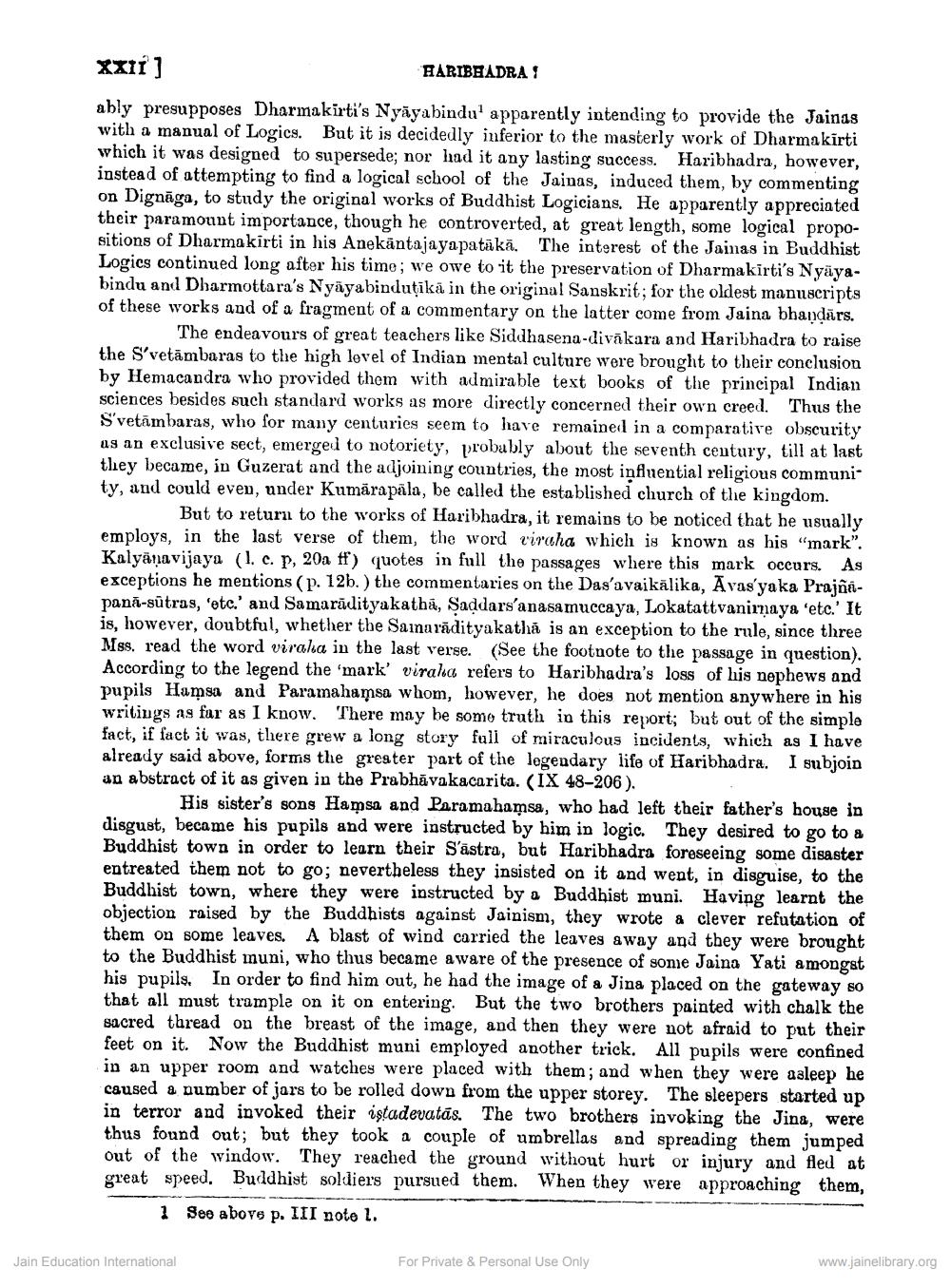________________
xxii]
ably presupposes Dharmakirti's Nyayabinda' apparently intending to provide the Jainas with a manual of Logies. But it is decidedly inferior to the masterly work of Dharmakirti which it was designed to supersede; nor had it any lasting success. Haribhadra, however, instead of attempting to find a logical school of the Jainas, induced them, by commenting on Dignaga, to study the original works of Buddhist Logicians. He apparently appreciated their paramount importance, though he controverted, at great length, some logical propositions of Dharmakirti in his Anekantajayapataka. The interest of the Jainss in Buddhist Logics continued long after his time; we owe to it the preservation of Dharmakirti's Nyayabindu and Dharmottara's Nyayabinduțika in the original Sanskrit; for the oldest manuscripts of these works and of a fragment of a commentary on the latter come from Jaina bhandars. The endeavours of great teachers like Siddhasena-divakara and Haribhadra to raise the S'vetambaras to the high level of Indian mental culture were brought to their conclusion by Hemacandra who provided them with admirable text books of the principal Indian sciences besides such standard works as more directly concerned their own creed. Thus the Svetambaras, who for many centuries seem to have remained in a comparative obscurity as an exclusive sect, emerged to notoriety, probably about the seventh century, till at last they became, in Guzerat and the adjoining countries, the most influential religious communi ty, and could even, under Kumarapala, be called the established church of the kingdom.
HARIBHADRA!
But to return to the works of Haribhadra, it remains to be noticed that he usually employs, in the last verse of them, the word viraha which is known as his "mark". Kalyanavijaya (1. e. p. 20a ff) quotes in full the passages where this mark occurs. exceptions he mentions (p. 12b.) the commentaries on the Das'avaikälika, Avas'yaka Prajnapana-sutras, 'ete.' and Samarüdityakatha, Saddars'anasamuccaya, Lokatattvanirnaya 'ete.' It is, however, doubtful, whether the Samaridityakatha is an exception to the rule, since three Mss. read the word virala in the last verse. (See the footnote to the passage in question). According to the legend the 'mark' virala refers to Haribhadra's loss of his nephews and pupils Hamsa and Paramahamsa whom, however, he does not mention anywhere in his writings as far as I know. There may be some truth in this report; but out of the simple fact, if fact it was, there grew a long story full of miraculous incidents, which as I have already said above, forms the grester part of the legendary life of Haribhadra. I subjoin an abstract of it as given in the Prabhavakacarita. (IX 48-206).
His sister's sons Hamsa and Paramahamsa, who had left their father's house in disgust, became his pupils and were instructed by him in logic. They desired to go to a Buddhist town in order to learn their S'astra, but Haribhadra foreseeing some disaster entreated them not to go; nevertheless they insisted on it and went, in disguise, to the Buddhist town, where they were instructed by a Buddhist muni. Having learnt the objection raised by the Buddhists against Jainism, they wrote a clever refutation of them on some leaves. A blast of wind carried the leaves away and they were brought to the Buddhist muni, who thus became aware of the presence of some Jaina Yati amongst his pupils. In order to find him out, he had the image of a Jina placed on the gateway so that all must trample on it on entering. But the two brothers painted with chalk the sacred thread on the breast of the image, and then they were not afraid to put their feet on it. Now the Buddhist muni employed another trick. All pupils were confined in an upper room and watches were placed with them; and when they were asleep he caused a number of jars to be rolled down from the upper storey. The sleepers started up in terror and invoked their istadevalds. The two brothers invoking the Jins, were thus found out; but they took a couple of umbrellas and spreading them jumped out of the window. They reached the ground without hurt or injury and fled at great speed. Buddhist soldiers pursued them. When they were approaching them,
1 See above p. III note 1.
Jain Education International
For Private & Personal Use Only
www.jainelibrary.org




